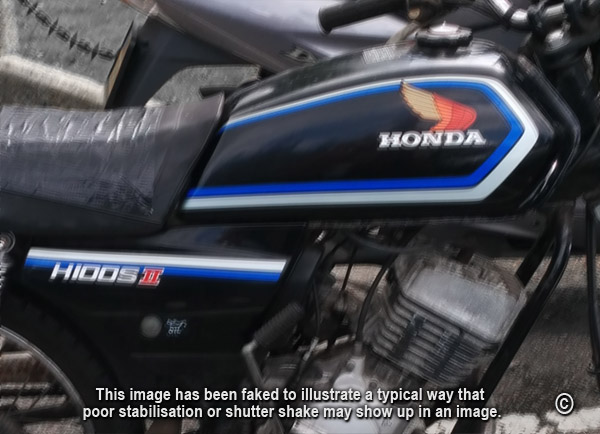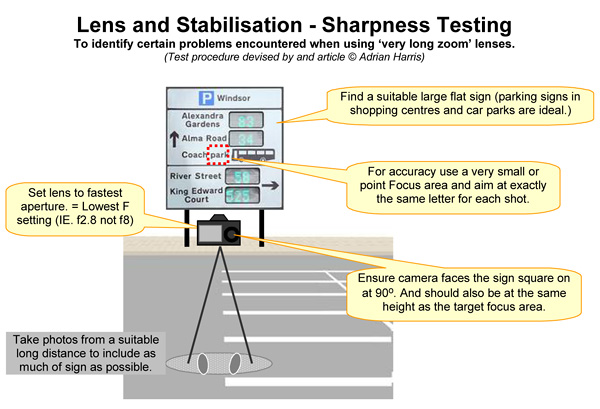 |
ARTICLE MENU
|
M4/3 System
(16th December 2016)
2. Lens
& Stabilisation - Sharpness Testing
to identify certain
problems encountered when using ‘very long zoom’ lenses.
(Test procedure devised by and article © Adrian Harris)


Test Method when Handholding
Camera:
 Handholding tests show the effectiveness of stabilisation on image
sharpness.
Handholding tests show the effectiveness of stabilisation on image
sharpness.
- Set lens to max zoom and wide open = fastest aperture.
(IE. Lowest f number. Example: f2.8, not f8. As using a small
aperture such as f8 could hide any lens sharpness faults and would
also slow down the test shutter speed).
- Ensure shutter speed = minimum of
2 x equivalent FF focal length.
(On M43, 400mm = 800mm FF = 1/1600th. The
faster the shutter speed used for the test the better, but stay
within reasonable ISO limits to prevent a poor image.)
- Set camera to smallest focus
square or point, and take careful aim at target letter.
(This will help prevent focus
errors).
- Stand firmly, brace your arms
against chest, hold breath, aim carefully at the target point and
fire off a short burst of shots.
(I use a series of 4 to 6 photos*
to ensure I get at least one good image in case of camera user
error!)
- Test 1: Turn OFF all stabilisation
(eliminates a possible problem source), take sequence of at least 6
photos.
-
Test 2:
Turn ON stabilisation and repeat the shots.
(If available try different stabilisation options).
- Test 3:
Repeat tests using a different camera or lens if available, to
compare.
Test Method when Camera on Tripod :
(A suitably rigid tripod is
essential.)
 Manufacturers advise switching stabilisation OFF when using a tripod.
Manufacturers advise switching stabilisation OFF when using a tripod.
- Prepare camera as in 1 - 3 above.
(Using a 2sec timer delay or a remote
shutter control will allow better images from slower shutter speeds
if desired.)
- No need for a long burst when
using a tripod.
(...but it is always wise to take a
couple of shots just in case of user error.)
- Do Test 1 and
Test 3 as described above.
Examine and compare all images
from each test sequence:
- Are they sharp - all over?
- Are the Stabilised shots sharp in
different random areas?
(a misaligned lens or over worked stabilisation can cause uneven
sharpness)
- Note which sequence produced the
highest rate of sharp shots.
Important Notes:
- When handheld shooting, park so that
you can use the car to steady your camera.
- If testing a suspect zoom lens,
repeat above test at different focal lengths.
- To ensure the camera focus is
EXACTLY the same when inverted, it may be best to use fully manual
focus control – but take care NOT to knock the focus control ring !
- *
EXIF data does not indicate whether stabilisation is On or Off, so
if you do this test and are also comparing how
stabilisation versus no stabilisation affects sharpness, ensure you make note of the
number of shots taken for each sequence!
1.
Off-Centre Lens & Sensor Alignment Testing.
(tests for lens optics and camera sensor alignment faults).
2.
Lens and Stabilisation - Sharpness Testing.
(tests for lens sharpness and image stabilisation issues).
3.
Front Focus & Back Focus Testing.
(tests for focus alignment setup accuracy between the camera and lens.)
Article ©
Adrian Harris
|
|
 |



